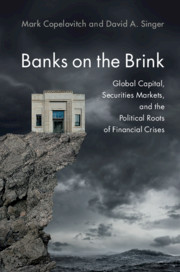Book contents
- Banks on the Brink
- Political Economy of Institutions and Decisions
- Banks on the Brink
- Copyright page
- Dedication
- Contents
- Figures
- Tables
- Preface
- Acknowledgments
- 1 The Politics and Economics of Financial Instability
- 2 Banking Crises, Capital Flows, and Financial Market Structure
- 3 Capital Inflows, Market Structure, and Banking Crises
- 4 O Canada? Unraveling the Mystery of Canadian Bank Stability
- 5 Finanzplatz Deutschland
- 6 Policy Responses
- References
- Index
- Political Economy of Institutions and Decisions
4 - O Canada? Unraveling the Mystery of Canadian Bank Stability
Published online by Cambridge University Press: 10 February 2020
- Banks on the Brink
- Political Economy of Institutions and Decisions
- Banks on the Brink
- Copyright page
- Dedication
- Contents
- Figures
- Tables
- Preface
- Acknowledgments
- 1 The Politics and Economics of Financial Instability
- 2 Banking Crises, Capital Flows, and Financial Market Structure
- 3 Capital Inflows, Market Structure, and Banking Crises
- 4 O Canada? Unraveling the Mystery of Canadian Bank Stability
- 5 Finanzplatz Deutschland
- 6 Policy Responses
- References
- Index
- Political Economy of Institutions and Decisions
Summary
O Canada! This is the national anthem of Canada, of course. But lately these words have been uttered in the most unlikely of contexts. Residents of countries around the world who have experienced the anguish of banking crises have looked at Canada’s remarkably stable banking system with awe and envy. Beginning in 2008, a global financial crisis swept North America and Europe, and several long-standing financial institutions with prestigious names – Lehman Brothers, Bear Stearns, Northern Rock, Merrill Lynch, Wells Fargo, and Fortis, to name a few – collapsed or required emergency bailouts. The crisis hit the United States the hardest, but the United Kingdom, Switzerland, Germany, Belgium, and many other countries faced debilitating bankruptcies and bank runs through 2010. Canada was different. No Canadian bank failed or required emergency funding from the government. Some Canadian banks even posted healthy profits during the height of the crisis, seemingly in proud defiance of their southern neighbor’s faltering financial system. Unsurprisingly, policymakers and social scientists around the world have wondered whether Canada holds the secret to financial stability, and if so, whether it can be replicated elsewhere.
- Type
- Chapter
- Information
- Banks on the BrinkGlobal Capital, Securities Markets, and the Political Roots of Financial Crises, pp. 88 - 123Publisher: Cambridge University PressPrint publication year: 2020

